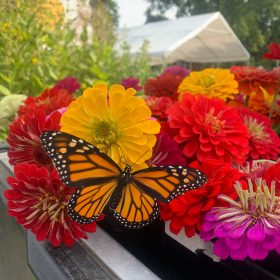
They’re famous for their annual, two-way mass migration from the Sierra Madre Mountains in Mexico to Canada and back. But these fascinating, unique insects from the Nymphalidae family are also important pollinators that spread beauty wherever they go.
Learn more during Butterfly Kingdom: Monarch Conservation at Queens County Farm Museum on Saturday, July 13, at 1 pm.
Insect expert Keith McManus, a Ph.D. candidate with a master’s degree in biology, leads this 90-minute event which is aimed for youth, but all are invited. Participants learn about the Monarch life cycle, milkweed, pollination, migration, feeding, and the ways humans can support this species. They also take a guided tour of Queens Farm’s Butterfly Garden.
Attendance is $10. Click here to register.
Queens Farm is a Certified Monarch Waystation, which means staffers grow plants that provide necessary food sources and habitat to help these butterflies thrive.
Spread out over 47 acres in Glen Oaks, Queens Farm is the Big Apple’s only working farm with livestock, heavy farm machinery, planting fields, and a vineyard. There’s free parking near the main entrance at 73-50 Little Neck Pkwy.

Monarch Butterflies: Did You Know?
Birds make two-way migrations, but insects don’t…except for the monarchs. They leave their northern breeding grounds to find warmer weather every autumn. When they get to Mexico, they take shelter in oyamel fir trees for the winter.
Their orange-and-black wings serve as warnings to predators.
They rely on milkweed plants for nutrition and shelter where the females lay eggs.
They can travel as much as 100 miles a day.
They smell with their antennae.
They can’t bite.
They drink through a long tongue called a “proboscis.”

Images: Queens County Farm Museum
